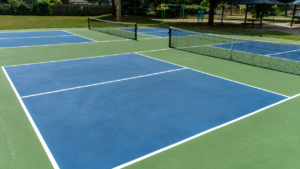Rally scoring in pickleball, the beloved and fast-paced paddle sport, has been captivating players and spectators alike with its dynamic gameplay and nail-biting exchanges. With the scoring system being the heartbeat of any competitive sport, understanding how rally scoring operates in pickleball is essential for players looking to dominate the courts or for enthusiasts simply seeking a deeper appreciation of this engaging game. So, whether you’re a seasoned player looking to improve your skills or a curious onlooker eager to unravel the intricacies of pickleball, this quick guide will provide you with all the insights needed to make the most of every thrilling rally.
Table of Contents
- Introduction: Understanding Rally Scoring in Pickleball
- Key Components of Rally Scoring and How It Differs from Traditional Scoring
- Mastering the Strategy: Tips for Excelling at Rally Scoring in Pickleball
- Common Mistakes to Avoid and Techniques to Implement in Rally Scoring
- Conclusion: Embracing the Excitement and Dynamic Nature of Rally Scoring in Pickleball
- Q&A
- Wrapping Up

Introduction: Understanding Rally Scoring in Pickleball
Pickleball, a fast-paced and exciting sport, has been gaining popularity worldwide. As you step onto the court, it’s important to familiarize yourself with the unique scoring system known as rally scoring. Rally scoring is a straightforward method used to determine which team wins a point in pickleball. Unlike traditional scoring systems, rally scoring allows points to be scored by both the serving and receiving team. This means that every serve or return could potentially result in a point for either team, keeping the game suspenseful until the very end.
To better understand rally scoring in pickleball, it’s essential to know the basics. Each game is played until one team reaches a score of 11, with a winning margin of 2 points. However, in tournament settings, games are often extended to 15 or 21 points. The first team to reach the designated score wins the game. Furthermore, each individual rally (a sequence of shots starting with the serve and concluding when the ball is out of play) can result in only one point being earned. The serving team will continue to serve until a rally is lost, at which point the opposing team takes over the serving duties.
In rally scoring, points can be won in various ways. A point is awarded if the opposing team fails to return the serve within the boundaries of the court, commits a fault during play, or hits the ball out of bounds. Additionally, when a team is serving, they can score a point if they successfully execute a shot that their opponent is unable to return. This rapid scoring system requires players to stay focused and maintain a high level of skill and strategy throughout the game.
In conclusion, understanding the concept of rally scoring in pickleball is crucial for players to excel in this exhilarating sport. With every serve and return being an opportunity to score, the game remains intense and unpredictable until one team achieves victory. So step onto the court, embrace the challenge, and let your skills shine as you strive for pickleball greatness!
Key Components of Rally Scoring and How It Differs from Traditional Scoring
Rally scoring is a scoring system widely used in various sports, most notably in volleyball. Unlike traditional scoring systems, rally scoring brings in a dynamic element to the game, injecting excitement and intensity into every play. Let’s explore the key components of rally scoring and how it sets itself apart from the more traditional scoring methods.
1. Every play counts: In rally scoring, every single play becomes crucial. Each team has the opportunity to score a point on every rally, regardless of who served the ball. This creates a thrilling, fast-paced environment where each team must give their all on every play.
2. Continuous gameplay: Unlike traditional scoring systems, rally scoring ensures continuous gameplay. Every time a point is scored, whether by the serving or receiving team, the ball is immediately put back into play. This eliminates interruptions, keeping the players and spectators engaged throughout the game.
3. Points on errors: Another significant difference in rally scoring is that points can be earned on either successful plays or opponent errors. Whether it’s an impressive spike or a missed serve, each play adds to the scoreboard. This aspect intensifies the pressure on players, as even the slightest mistake can cost their team a point.
4. Decisive factor: Rally scoring ensures a quicker and more definitive result. By using this scoring system, matches are played to a predetermined time limit or a specific point target, which could be different for each set. This adds an element of strategy for teams, forcing them to constantly adapt and adjust their gameplay.
Rally scoring undoubtedly adds an extra level of excitement to sports like volleyball, leveling the playing field and ensuring that every single play matters. It fosters a sense of urgency, pushing players to give their utmost effort throughout the game. So, the next time you watch a volleyball match, pay close attention to the dynamic nature of rally scoring and the remarkable impact it has on the game.
Mastering the Strategy: Tips for Excelling at Rally Scoring in Pickleball
In the fast-paced world of pickleball, mastering the art of rally scoring can give you a significant advantage on the court. Rally scoring, where a point is awarded on every serve regardless of who served, requires a strategic approach and keen attention to detail. Here are some tips to help you excel at rally scoring in pickleball:
- Stay focused: Maintaining concentration is crucial in rally scoring. The constant back-and-forth nature of the game demands your unwavering attention, so try to block out distractions and stay fully present.
- Consistent serves: Since every serve can score a point, it’s important to focus on delivering consistent and reliable serves. Practice different types of serves, such as the drive serve or the lob serve, to keep your opponents guessing.
- Adaptability: Be prepared to adjust your strategy on the fly. Rally scoring often requires quick decision-making to counter your opponents’ moves. Stay flexible and willing to change tactics when necessary.
- Strategic shot placement: Rather than relying solely on power, focus on precision in your shots. Aim for open spaces on the court, exploiting weak spots in your opponents’ positioning. This will force them to scramble and increase your chances of winning the point.
- Mind the dink: The dink, a short and soft shot, can be your secret weapon in rally scoring. Incorporate dinks into your game to disrupt your opponents’ rhythm and create opportunities for winning points.
By incorporating these strategies into your game, you’ll be well on your way to mastering the art of rally scoring in pickleball. Remember, practice makes perfect, so grab your paddle and start honing your skills on the court!

Common Mistakes to Avoid and Techniques to Implement in Rally Scoring
In the exhilarating world of rally scoring, there are common mistakes that can creep into your game and techniques that can elevate your performance. To help you stay on top of your game, here are some valuable insights to avoid those pitfalls and implement winning strategies.
1. **Lack of communication:** Rally scoring is a team sport, and effective communication is key to success. Avoid misunderstandings by establishing clear signals between teammates. Develop a system of hand gestures, cheers, or even coded words to convey important information swiftly and accurately.
2. **Inconsistent serve technique:** Serving is not just about power but precision. Avoid inconsistent serves by practicing proper technique. Focus on consistent footwork, ball toss, and wrist snap to increase accuracy and control. Regular drills can help fine-tune your serve and minimize your vulnerability in pressure situations.
3. **Overlooking defensive strategies:** While the offensive aspect of rally scoring tends to get more attention, solid defensive strategies are equally important. Make it a priority to practice defensive stance and positioning, and anticipate your opponent’s moves. Reacting quickly with well-executed digs and blocks can turn the tide of the game in your favor.
4. **Lack of adaptability:** Being able to adapt to different playing conditions and opponent’s strategies is crucial in the dynamic world of rally scoring. Develop a versatile gameplay style that can adjust to different surfaces, weather conditions, or player strengths and weaknesses. Regularly analyze your own performance and seek opportunities to learn from your experiences.
Remember, success in rally scoring is not just about raw talent, but also about avoiding common mistakes and implementing effective techniques. By improving your communication, serving technique, defensive strategies, and adaptability, you will be well on your way to becoming a formidable force on the court.
Conclusion: Embracing the Excitement and Dynamic Nature of Rally Scoring in Pickleball
Embracing the excitement and dynamic nature of rally scoring elevates the game of pickleball to a whole new level. This innovative scoring system not only adds a thrilling element to the sport but also enhances the overall experience for players and spectators alike.
With rally scoring, every serve, return, and point becomes a crucial moment, fueling the intensity and competitiveness of each match. It keeps players on their toes, constantly strategizing and adapting to the ever-changing momentum of the game. The fast-paced nature of rally scoring ensures that no point is ever truly lost, keeping the suspense alive until the very last shot.
Moreover, rally scoring brings a fresh dose of unpredictability to pickleball. This format fosters an environment where comebacks are always possible, adding an element of surprise and making every match an exhilarating spectacle. The combination of strategy, skill, and quick thinking required in rally scoring tests players’ abilities to the limit, pushing them to dig deep and unleash their full potential.
Q&A
What is rally scoring in pickleball?
Rally scoring is a scoring system used in pickleball where points can be scored by both teams on every rally, regardless of who served. It adds an exciting element to the game as each point counts towards the final score.
How does rally scoring work in pickleball?
In rally scoring, each team has the opportunity to score a point on every rally. A point is awarded to the serving team if they win the rally and a point is awarded to the receiving team if they win. The first team to reach 11 (or 15, depending on the agreed-upon game rules) points, with a two-point lead, wins.
What are the advantages of rally scoring in pickleball?
Rally scoring increases the pace of the game as every point matters, making it more thrilling for both players and spectators. It eliminates the need for side-out scoring, where only the serving team can score, bringing fairer competition to pickleball.
Does rally scoring change the server rotation in pickleball?
No, rally scoring does not change the server rotation in pickleball. The server rotation remains the same, with the serving team rotating after every side-out.
Are there any specific rules to follow for rally scoring in pickleball?
The rules for rally scoring in pickleball are generally the same as regular pickleball, with the only difference being the scoring system. Both teams can score on every rally, and the first team to reach the agreed-upon point limit with a two-point lead wins the game.
Wrapping Up
As we conclude our journey through the exhilarating world of rally scoring in pickleball, our minds are filled with the jubilant sounds of paddles meeting balls, the rhythmic bouncing, and the uproarious cheers of victory. We’ve explored the intricacies of this fast-paced scoring system, delving into its origins, rules, and the strategic mindset required to master it.
With rally scoring, we have witnessed the transformation of pickleball, a sport that was once dominated by sideout scoring, into a dynamic battlefield where every player’s skill, agility, and mental fortitude are put to the test. The relentless pace of rally scoring demands unwavering focus, lightning-fast reflexes, and a keen understanding of one’s opponent.
While rally scoring may seem like a daunting challenge, it undoubtedly injects a surge of adrenaline, making every match an enthralling spectacle for players and spectators alike. The constant back-and-forth, the tense exchanges, and the nail-biting finale all conspire to create an electrifying atmosphere that can only be experienced on the pickleball court.
As we bid adieu to our exploration of rally scoring, let us carry with us the lessons learned from this fast and furious rating system. Whether you’re a seasoned pickleball aficionado or a newcomer eager to embrace the sport, rally scoring promises an unparalleled adventure, one that tests not only your physical prowess but also your mental tenacity.
So, gather your paddles, lace up your shoes, and dive headfirst into the world of rally scoring in pickleball. Let the thrill of each point, each rally, and each victorious moment guide you towards a deeper appreciation for the sport that has captured the hearts of millions worldwide.
As the final echoes of the pickleball rallies fade into the background, remember that the essence of rally scoring lies not just in the points earned but in the joy of the game itself. Embrace the challenges, relish the triumphs, and savor every exhilarating moment – for pickleball is a symphony of determination, skill, and unequivocal passion.
As an affiliate, my content may feature links to products I personally use and recommend. By taking action, like subscribing or making a purchase, you’ll be supporting my work and fueling my taco cravings at the same time. Win-win, right?
Want to read more? Check out our Affiliate Disclosure page.




